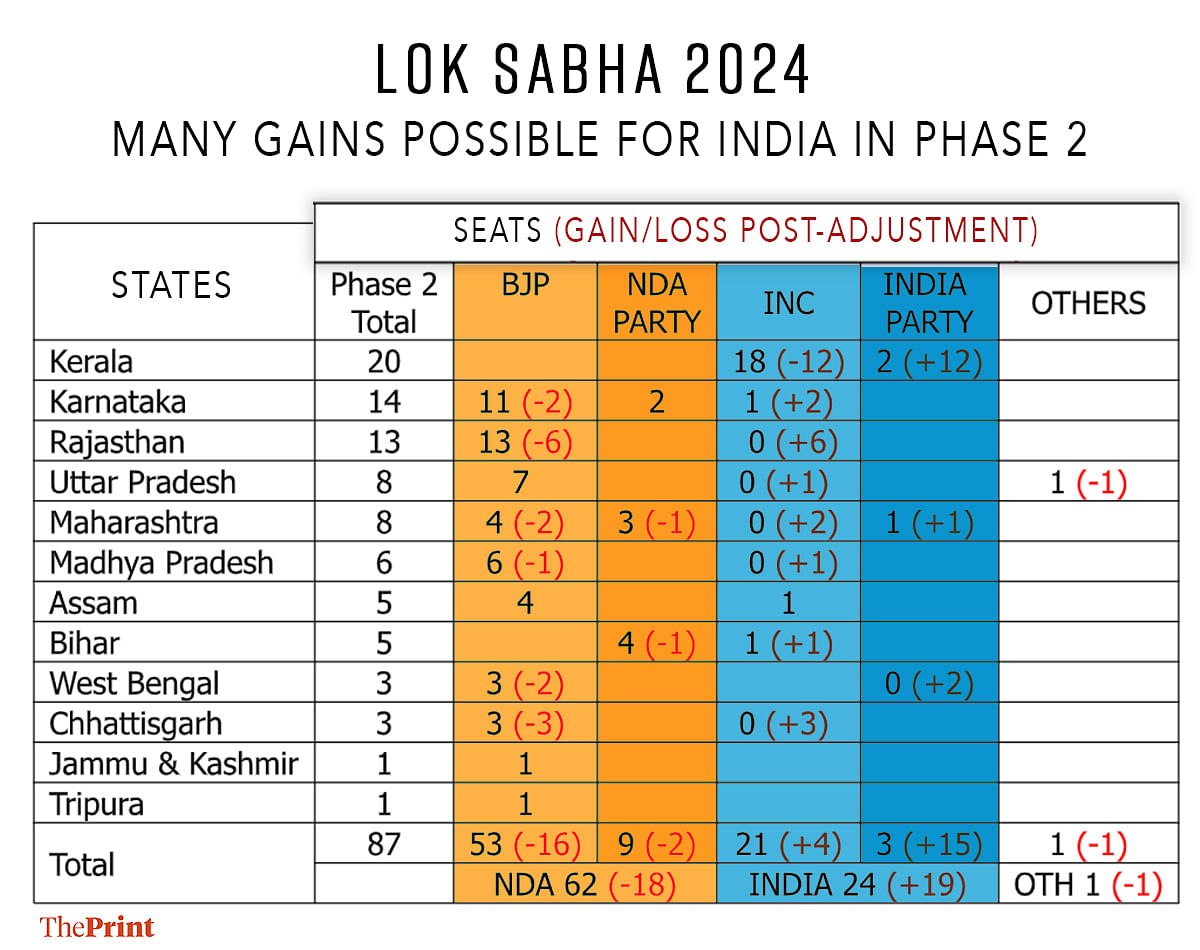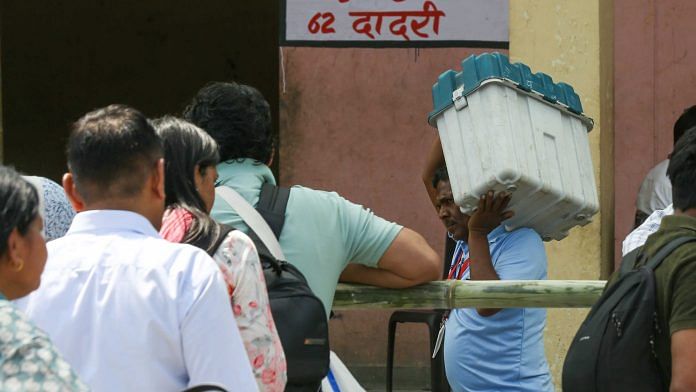The BJP faces a peculiar problem in the second phase of the 2024 Lok Sabha elections. It starts the race with a massive lead that is well-nigh impossible to defend. In 2019, the BJP and its allies won nearly three–fourths — 62 of the 87 — seats that went to polls in Phase II; the INDIA bloc won just 24 seats. Yet, the comfort for the ruling coalition is deceptive for several reasons.
The 2019 tally does not reflect the situation on the ground as measured by assembly elections held since then. Once we adjust the tally for the leads in the assembly elections post-2019 (figures in brackets in red font in Table 1), the race is evenly matched: 44 seats to NDA vs 43 seats to INDIA. Besides, the BJP’s problem is that while its own seats are differently vulnerable in all but a couple of states, the seats held by INDIA are virtually a no-go zone for the BJP. The BJP can only lose in this phase. And if the turnout in the seats held by NDA drops more than it does in the INDIA seats, as it did in the first phase of polling on 19 April, the losses for the NDA could be significant.
The main reason for the non-vulnerability of the seats held by INDIA bloc is Kerala, where all the 20 seats go to polls in the second phase. The BJP is yet to open its account in a Lok Sabha election here. It has steadily improved its vote share though. In 2019, the BJP was the runner-up in one seat – Thiruvananthapuram – that it lost by almost 10 percentage points and secured more than a fourth of the vote-share in two other seats. The BJP would be ecstatic if it can score its first victory in Kerala, but that cannot make much difference to its overall tally.

The real question in the state, as always, is the respective share of the two allies in the INDIA bloc: the Indian National Congress-led United Democratic Front (UDF) and the CPI-M led Left Democratic Front (LDF). In 2019, the present UDF constituents swept all but two seats in the state with a 7 percentage point lead in vote-shares. The LDF turned the tables in the subsequent assembly election and had a 6 pp advantage,which could translate into a lead in 14 of the 20 Lok Sabha seats. However, in Kerala, the logic of assembly election does not apply to the Lok Sabha election. In the last three decades, with the exception of 2004, the UDF has always outperformed the LDF in national elections, as the state’s highly sophisticated electorate prefers UDF in Lok Sabha for its more salient national presence. This time, the LDF would be happy if it can snatch another 2-3 seats from the UDF.
Also read: It’s ‘Advantage INDIA bloc’ in the first phase of Lok Sabha election
Battleground states
The BJP’s fate in this phase will be decided in the battleground states of Karnataka, Rajasthan, and Maharashtra where it did very well last time and faces a stiff competition now. In Karnataka, the first lot of 14 constituencies going to polls are all located in the southern part of the state encompassing the Old Mysore, Coorg, and the coastal regions.
The BJP has traditionally been strong in the coastal regions but not in Old Mysore, where the Congress had its sole victory and the Janata Dal (Secular) secured one seat in 2019. The dominant Vokkalliga caste holds sway over these rural regions, just as Jats do in Western Uttar Pradesh. The BJP is hoping its alliance with the Vokkaliga-led JD(S) – similar to its alliance with the Rashtriya Lok Dal (RLD) in Uttar Pradesh — will help it make up the deficit. Going by past electoral records, it is a smart alliance. The Congress was poised to win 9 of the 14 Karnataka constituencies in this phase if we go by the 2023 assembly election results. But if one adds the vote-shares of both the BJP and the JD(S), the INC’s lead drops to just 3 seats. Of course, this assumes a perfect transfer of votes between these new allies, which may not happen. Also, the Congress is banking onthe popularity of the Siddharamaiah government and its five guarantees that are evident on the ground. If that works, the formidable BJP-JD(S) alliance could lose 3-5 seats in its heartland, paving the way for bigger losses in the second phase.
Rajasthan also offers the INDIA bloc some gains, though not as big as in the first phase. The three regions that go to polls in the second and final phase – Marwar, Mewar, and Haroti — are the ones where the BJP swept in 2019 and performed very well in the assembly election in 2023. On its own, the Congress stands a chance in only 4 of the 13 constituencies voting in this phase if its assembly performance gets replicated, but it can add three more seats because of the alliance with the Rashtriya Loktantrik Party (RLP) and a last-minute understanding with the Bharat Adivasi Party. The NDA is also facing trouble in Barmer from a young charismatic independent candidate. That’s another 3-5 seats that the BJP stands to lose.
In Maharashtra, where the elections are spread across five phases, the contest heats up in this phase where the complications of the new alliances of the NDA with breakaway factions of powerful state parties come to the fore. The NDA has a huge advantage in the number of incumbent MPs and a substantial advantage in the number of MLAs. Their allies, the Eknath Shinde-led Shiv Sena and the Ajit Pawar-led Nationalist Congress Party (NCP), have managed to capture the original party names and symbols. Yet those who control the party symbols do not necessarily command the loyalty of voters. All indicators suggest that the original parties from which these factions broke away — the now renamed Shiv Sena (Uddhav Balasaheb Thackeray) and the NCP-Sharadchandra Pawar — control a bigger chunk of both the cadre and the electorate. If the Shiv Sena and NCP assembly election votes get split into equal halves, the BJP and its partners stand to lose 3 of the 8 seats that go to polls in this phase. The presence of the Vanchit Bahujan Aghadi (VBA) adds more complications to the mix. The VBA is contesting 6 of the 8 seats in this round, including its leader Prakash Ambedkar from Akola. It is a much weaker force than in 2019, but yet could damage the INDIA bloc in close seats. All in all, the INDIA bloc (called MVA in Maharashtra) can expect modest gains in this round.
There are marginal setbacks for the BJP in other states where a handful of seats go to polls in the second phase. It so happens that the Congress has a fair chance in all the three seats going to the polls in Chhattisgarh. Two of the topmost Congress leaders of the state – former CM Bhupesh Baghel and former state home minister Tamradhwaj Sahu – are contesting in this round. In West Bengal, the BJP is a major player in the three north Bengal seats, though the Trinamool Congress (TMC) has wrested control of two of these seats in the assembly election. The Seemanchal and Bhagalpur regions of Bihar with a substantial population of Muslims will vote in this phase. The principal challenge for the Mahagathbandhan(INDIA bloc in Bihar) here is its internal conflict in Purnea and the challenge from All India Majlis-e-Ittehadul Muslimeen (AIMIM) in Kishanganj.
The electoral equation may not change very much in the remaining states. The BJP-RLD combine enjoys a clear lead over the Samajwadi Party-Congress alliance in the 8 western UP seats going to the polls in the second phase. Two factors could change the balance here: Mayawati’s revival of the separate state demand, once championed by the RLD; and the resentment among Rajputs who perceive that their community has been short-changed by the BJP in candidate-selection. In Madhya Pradesh, although 7 seats were to vote in this phase, elections are taking place in 6 as voting in Betul seat had to be postponed due to the death of the Bahujan Samaj Party (BSP) candidate. The BJP held all of these and led in all but one seat in the recent assembly election.
Finally, the X-factor. The constituencies in this phase witnessed 70 per cent turnout in 2019, the highest turnout of all phases. Will the turnout drop in this phase in 2024, especially in the Hindi-speaking states? This would worry the BJP as the drop in turnout in the first phase seats where the NDA was strong and winning in 2019 was more than double than the drop in turnout in seats where INDIA had won in 2019. The former saw a drop of 5.1 percentage points while the latter’s was just 2.4 percentage points. If the turnout follows a similar pattern as Phase I, the challenges for the BJP for the subsequent phases may intensify.
Yogendra Yadav is National Convener of the Bharat Jodo Abhiyan. He tweets @_YogendraYadav. Shreyas Sardesai is a survey researcher associated with the Bharat Jodo Abhiyan. Rahul Shastri is a researcher. Views are personal.
(Edited by Prashant)







LMAO some very salty butthurt Chaddhis in the comment section. Keep doing what you’re doing Yogendra Yadav.
Jogendra Jadhav strikes again
If everytime I had a dollar for Yogendra Yadav’s predictions, my networth would remain the same
Red salute to comrade Yadav.
Yogendra Yadav needs to stop worrying about BJP and start worrying about parties that he has aligned himself with. He is a self anointed oracle of Indian democracy who not many Indian care about.